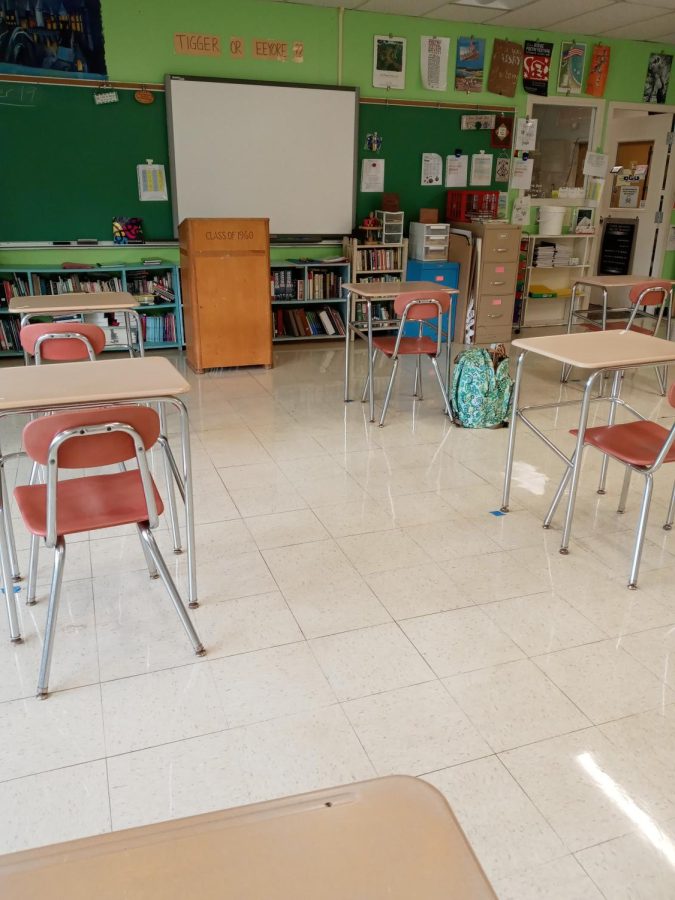How Honors Classes are a Flawed System
In our school, the tracking system is more flexible. There are many high level courses offered outside of the honors program. In many other schools, this is not the case.
The pinnacle of high school education is often considered to be the honors class. The best and brightest from each grade separated and isolated into their own little group. These cliquey, stifling groupings are highly problematic, especially in the way that students are placed into the class. While the honors program does allow motivated students to pursue more advanced classes, the way students are placed in the program is flawed. It relies on placement tests, teacher recommendations, and parent intervention, and it often fails to accommodate students that could excel if given the chance.
The honors class is the highest track in the high school tracking system. Tracking, or sorting students into classes based on skill level, has been around for 90 years now, and just within the past two decades it’s becoming more and more controversial. Students are placed on either the honors track or lower tracks depending on academic performance(“Tracking and Ability Grouping in Middle Level and High School,” 1). Tracking is not something to be taken lightly, as it has a large impact on high school success and college attendance, as it ultimately determines the quality of a student’s education. The highest tracks usually have the most qualified teachers and quality materials (“Tracking and Ability Grouping in Middle Level and High School,” 2). The problem with tracking is that it is rarely fair. None of the usual methods of placement are perfect, and many students who would do well in the honors program are not given that opportunity for reasons outside their control.
The whole system would be a lot more fair if testing, teacher recommendation, and parent involvement were removed from the placement process, and the track a student is placed on is determined by the student themself. A student should simply have to ask, and if they have the motivation to take a challenging class, they should be allowed to. They should not be limited to the classes that are deemed fitting for the track they were placed on by someone else. Challenging classes should be made available and accessible to all students.
Some might argue that testing requirements are necessary to ensure that a student is qualified to take a course. At first glance, this seems to be the most fair way to determine class placement, as it is quantitative and removes bias. However, under closer scrutiny, a test score does little to indicate whether or not a student will succeed in the honors program or not. Michelle Obama was famously quoted saying “if my future were determined just by my performance on a standardized test, I wouldn’t be here” (Ershova, 1). Despite struggling on standardized tests in high school, Michelle Obama went on to attend Princeton, a prestigious university at which she was very successful. Many students just like her struggle during tests, but are capable of excelling academically. Instead of needing a certain test score to qualify for a class, a student should be informed of the level of work that is expected and the difficulty of the course, and if they still wish to take it, they should be allowed to do so. If that student then goes on to struggle in that course, they should be allowed to work through the challenge, as it was their choice. A study conducted by Maureen Hallinan came to the conclusion that “regardless of ability, students will generally attain higher achievement in a higher level group” (Hallinan, 1). With this in mind, students should be placed in as high a level course as possible. While concerns have been raised that challenging a student by placing them above their skill level could be detrimental and lead to discouragement, the academic benefits far outweigh these concerns. Additionally, higher level courses tend to foster better learning environments, helping students to feel less overwhelmed when facing difficult subjects (Hallinan, 15).
Another issue with placement tests is that the tests are not always offered to everyone. When I first moved to Galway, I had a great academic record. I had high standardized test scores, and a long history of excellent report cards. But, I missed the placement tests by 2 months, so the accelerated program was never mentioned to me or my parents. I was left on the normal track until I eventually proved myself and worked my way into some honors classes. But, by then, it was too late for the accelerated track. With help from my teachers, I was still able to take difficult classes, but it took a recommendation from my teachers. What would have happened if I didn’t have the support of my teachers?
A student’s future should also not be determined by a teacher’s judgment at a specific point during their career. When schools use this placement method, they are assuming that a student will behave the same way in every class, even as they grow older and more responsible. It assumes that students have “fixed ability” and do not have capacity to grow academically or change for the better (Oakes and Guiton, 26). In a study conducted by Jeannie Oates of University of California, Los Angeles, and Gretchen Guiton of University of Southern California, a high school principal “conveyed his belief that the high school is largely powerless to interrupt predictable patterns when he told us that kindergarten teachers can accurately identify those children who will be at-risk in high school” (Oakes and Guiton, 26). This was his way of justifying the way his school uses teacher recommendations early on to place students on tracks that they are stuck with for the remainder of their academic career. Of 20 teachers questioned within that same school, 14 could not think of a student that made improvements and switched from a lower track to a college preparatory track (Oakes and Guiton, 26). How can you possibly look at a kindergartener and know right then that they will not go to college? How can you judge someone based on their middle school, or even elementary school self, and from that determine the educational opportunities that should be offered to them?
Parent intervention is just another unfair way to determine the placement of a student. While some students have highly motivated, supportive parents, other students are more independent, and they should not be punished for lack of parental intervention in their education. To exacerbate the situation, many methods of acceleration depend on parents paying for testing, something low income families usually cannot afford to do (Siegel-Hawley, Taylor, Frankenberg, and Bridges, 41). A student’s academic outlook should not be determined by the motivation of their parents or the financial resources afforded to them.
The current system of highschool tracking and honors programs leaves much room for improvement, but if tracking was based on the student’s decision rather than that of a teacher, parent, guidance counselor, or a test score, the whole system would be infinitely better. The National Association of Secondary School Principals concedes that “Whether right or wrong, tracking is a generally accepted and a central part of the culture of secondary schools and will not be easily abolished” (“Tracking and Ability Grouping in Middle Level and High School,” 4). To get rid of the system as a whole is a daunting task, and is not necessary. It is reasonable to say that there should be different pathways through highschool for students with different goals. It is not reasonable for someone else to tell a student which path their life will take. Class placement should be flexible and determined by the student.
Works Cited
Ershova, Sophia. “Standardized Tests are Inaccurate.” The Sandbox News. St. Petersburg
College. 11 February 2017. https://sandbox.spcollege.edu/index.php/2017/02/ standardized-tests -are-in accurate/. Accessed 5 January 2023.
Hallinan, Maureen T. “Ability Group Effects on High School Learning Outcomes.” Institute for
Educational Initiatives. 2000. https://files.eric.ed.gov/fulltext/ED467684.pdf. Accessed 4 January 2023.
Oakes, J., & Guiton, G. “Matchmaking: The Dynamics of High School Tracking Decisions.”
American Educational Research Journal. 1995. https://doi.org/10.3102/00028312032001 003. Accessed 14 December 2022.
Siegel-Hawley, Geneveive. Taylor, Kendra. Frankenberg, Erica. Bridges, Kimberly. “Segregation
within Schools: Unequal Access to AP Courses by Race and Economic Status in Virginia.” Center for Education and Civil Rights. April 2021. cecr.ed.psu.edu/sites /default/files/Segregation_within_Schools_Unequal_Access_Virginia_2021.pdf. Accessed 14 December 2022.
“Tracking and Ability Grouping in Middle Level and High School.” National Association of
Secondary School Principals. 13 July 2006. www.nassp.org/tracking-And- ability- grouping-in-middle-level-and-high-schools/#:~:text=The%20term%20tracking%20refers%20to,is%20appropriate%20to%20their%20needs. Accessed 14 December 2022.

Sara is a senior who has been writing for EMC for six years. She is involved in many clubs, including Robotics, Impressions, Science Club, NHS, and EMC....


Abi Gullett • Jan 12, 2023 at 3:19 pm
I loved this article. I have been talking with other students in the honors track who feel this way as well. I personally think that in Galway it isolates grades and makes interacting with other hard. I have been in the honors course and I can remember from 8th grade up only having classes with those in my honors classes until midway into high school. We had a different lunch period, and a gym class with only each other. Other kids who were just as smart as we were got taught like they weren’t. The honors course also has put expectations on the kids taking them. For example, why is it taking so long you are honors kids, honors kids shouldn’t behave like this, honors kids shouldn’t be so distracted. Honors kids are pushed more and told to be better but kids not in those courses aren’t encouraged the same way which is detrimental to their education.